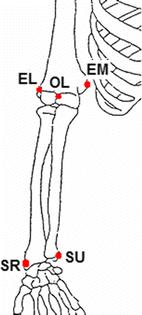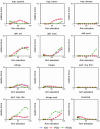Development of a comprehensive musculoskeletal model of the shoulder and elbow
- PMID: 22038240
- PMCID: PMC3223593
- DOI: 10.1007/s11517-011-0839-7
Development of a comprehensive musculoskeletal model of the shoulder and elbow
Abstract
The Delft Shoulder and Elbow Model (DSEM), a musculoskeletal model of the shoulder and elbow has been extensively developed since its introduction in 1994. Extensions cover both model structures and anatomical data focusing on the addition of an elbow part and muscle architecture parameters. The model was also extended with a new inverse-dynamics optimization cost function and combined inverse-forward-dynamics models. This study is an update on the developments of the model over the last decade including a qualitative validation of the different simulation architectures available in the DSEM. To validate the model, a dynamic forward flexion motion was performed by one subject, of which the motion data and surface EMG-signals of 12 superficial muscles were measured. Patterns of the model-predicted relative muscle forces were compared with their normalized EMG-signals. Results showed relatively good agreement between forces and EMG (mean correlation coefficient of 0.66). However, for some cases, no force was predicted while EMG activity had been measured (false-negatives). The DSEM has been used and has the potential to be used in a variety of clinical and biomechanical applications.
Figures





References
-
- Nikooyan AA, Zadpoor AA. Mass-spring-damper modeling of the human body to study running and hopping: an overview. Proc Inst Mech Eng Part H J Eng Med (in press) - PubMed
Publication types
MeSH terms
LinkOut - more resources
Full Text Sources

